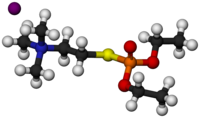Echothiophate
 | |
 | |
| Clinical data | |
|---|---|
| Trade names | Phospholine |
| Routes of administration | Topical (eye drops) |
| ATC code | |
| Identifiers | |
| |
JSmol) | |
| |
| |
| | |
Echothiophate (Phospholine) is an irreversible acetylcholinesterase inhibitor.[1]
Uses
It is used as an
Echothiophate binds irreversibly to
Mechanism of action
It covalently binds by its phosphate group to serine group at the active site of the cholinesterase. Once bound, the enzyme is permanently inactive and the cell has to make new enzymes.
Shortage
Wyeth Pharmaceuticals stopped manufacturing echothiophate iodide in the US in 2003. After contacting the American Academy of Ophthalmology (AAO), Wyeth rescinded their decision and, according to AAO public relations representative Michelle Stephens, the AAO and Wyeth were in talks for about a year about manufacturing it.[2]
In the meantime, a worldwide shortage of the drug has occurred.[when?][citation needed]
Chemistry
Echothiophate is made by reacting diethylchlorophosphoric acid with 2-dimethylaminoethylmercaptan, giving S-(2-dimethylaminoethyl)-O,O-diethylthiophosphate, which is alkylated by
References
- PMID 15277498.
- ^ "Eurotimes article: "Echothiophate iodide shortage leaves US specialists struggling to find alternative for acute cases"". Archived from the original on 2006-06-19. Retrieved 2006-08-13.
- ^ H.M. Fitch, U.S. patent 2,911,430 (1959)

